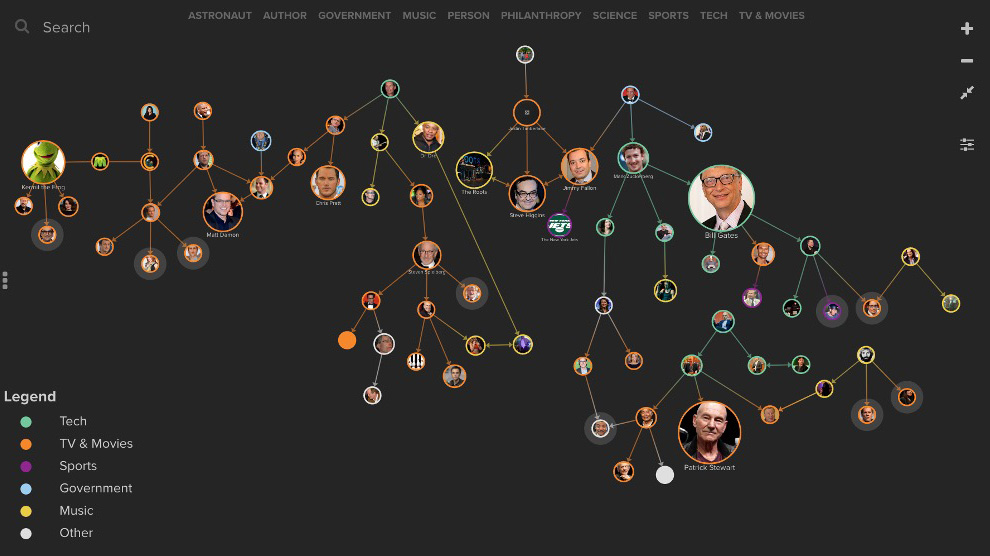Visualising Data
A man walks into a bar…and leaves a data trail, ba-dom-cha. Not the answer you expected, but maybe the answer you need? Whenever a customer uses your product, they leave a data trail. If you want to capture and analyse these points of sale, you need a data ecosystem.
13 October 2022 · 8 min read


An ‘ecosystem’ is the interaction of organisms with their physical environment. A data ecosystem is a method of capturing, storing and analysing the numbers that occur during this interaction and visually representing what they mean. So let’s get back to our man in the cocktail bar. He walks in, heads to the bar, orders a drink, taps his card and goes to sit down. Let’s take the credit card tap as a data source. You have the 16-digit primary account number (PAN), cardholder name, service code, and expiration date. You have the time of purchase and the amount. Let’s chuck in what we know from your EPoS system. You capture his preference from a series of menu options, the contents of his drink and their removal from your stock. You know what he will ingest, how much he’s prepared to spend on your product, what he prefers to pay with and how long it takes him until he orders another. Let’s say you’re also capturing smartphone data. Even on a fundamental level, you’re probably capturing date of birth and emails for your wifi login. You may be collecting data from apps on social media usage and interactions, event ticket sales, direct marketing and website analytics. You may have a food or drink delivery app. On a more sophisticated level, you might be looking at SMS or pay-per-click marketing techniques that use ring-fencing GPS location or heat-mapping data. Overwhelmed much? Well, yes, because you need to know how all these data sets interact and what that interaction tells you so you can make marketing, operational and pricing decisions.
“10 am, rain or shine, I have a meeting with my finance guy, and we talk numbers. Not just profit and loss, but full-on data analysis. We look at everything from event start times, weather, seasonality, adverts or marketing campaigns, website activity: everything. Everything we do is a result of what we’ve ever done. It's like building a constant mindfulness of what’s happening.
Peter Clucas, owner of the Lost Boys and True Romance bars in Camden, London.
A data ecosystem is a platform (bespoke made using programming language or an off-the-peg cloud-computing service) that combines data sets from numerous providers and allows you to extrapolate into valuable forms of analysis.
Four Ways You Can Use Data Ecosystems
- There are huge data ecosystems that you can access, sometimes in return for a contribution. These are so big that they’re run by institutions or organisations like the European Union or Python. They use Big Data and machine learning. One worth checking out is ODI (Open Data Institute), a non-profit organisation working with businesses and governments to build an open, credible shared data ecosystem.
- Or you can set one up with collaborators of your choice. For example, Barbi (the Bristol Association of Restaurants, Bars and Independents) connects all the independent food and drink venues in Bristol, and Bath Hacked publishes council data in readable maps. You’ll need to either design your own or use a cloud-based service.
- Or keep one just for your sites. No two organisations leverage the same data in the same way. As such, each has a unique data ecosystem. Again, it will require some design and build time but will be hugely efficient if made well.
- You can look at the data you collect in your venue and create a data ecosystem map to illustrate the different actors in the system and how value is exchanged across it. Just this level of understanding can help a small business.
“We use cloud-based data storage to help our members develop new business and access new information and opportunities. We would never share raw data, but we use it for the common good. For example, we created our own track and trace app during the pandemic. Before that, we created the Barbi food ordering app to contend with multinationals strangling independents with high commission fees.
Brendon Murphy, Barbi, Bristol.
Example Data Ecosystem Maps
Creating a data ecosystem map is the cheapest and easiest way to make the most of your data in a small-to-medium business. The map of the data ecosystem is nothing more than a straightforward, graphical visualisation of the data network and the company’s resources. It presents all members of the data exchange network and distribution channels and precisely identified and defined relationships between members of that network.

This will help you improve data flow, identify the impact of each interaction, look for new benefits, define new standards and identify new stakeholders.
Build a Data Ecosystem Map With Me
- Establish your SCOPE. What are the boundaries you will set in place? What habitat are we looking at? Do you want to see the entire company? Then you need to include staff and other stakeholders. Do you want to look at the customer experience? If so, your scope is the bar itself. Think about this as a physical space and keep it simple.
- Define your ACTORS. Who does what inside this space? Identify each member of the ecosystem. These can include customers, colleagues, competitors, partners and any other influential people.
- Make CONNECTIONS. This is your most significant task. You need to identify the relationships between members of the data ecosystem accurately and discover any actual and potential barriers and opportunities for development.
- Refine the DETAILS. These relationships can be fixed or loose, concrete or conceptual, or hard or soft values — a hard value would be financial, whereas a soft value could be something like advice.
“We keep all our martini ingredients at sub-zero temperatures (-20º). The bar was designed with these big freezers in mind, so we have lots of capacity. Our recipe is a 7:1 ratio, and we reached that in the way we do with many of our drinks. We make all the different variations and then do a blind taste test and come to a conclusion as a collective. Our goal is to look at what is most optimal or most efficient, so we’re attempting to control the speed at which the temperature and dilution reach their target with the most consistency. If you take all the romance away and your only goal is to make the best martini possible, it comes down to just four variables: how much spirit, how much vermouth, how much water and how cold.”
Kevin Armstrong, Satan’s Whiskers, London.
Let’s say we wanted to find the perfect house martini style, so we look at data from one Friday night, one bartender in one bar, and collect information on all the potential details. I’ve drawn a rudimentary map of a martini ordering data ecosystem. In the blue circles, I’ve added the actors. In this case, the customer ordering, the bartender making and the bar manager arranging the martini specs. The solid arrows show data that is fixed and will never change. For example, the ABV of the gin will never change because gin does not perish. In the same way, the data set for the botanical blend and production methods will not change throughout the evening. The bar manager makes the contract with the brand, and therefore these data sets are in his control. Similarly, those data sets affected by the bartender on shift are in his circle and the customer in his. However, the recipe’s ratio might change due to the customer’s asking for a specific spec. So might the music change and ambient noise, scent or temperature. The bartender might spill more gin into the jigger than he is meant to or have a poor interaction with the guest. These things can be mitigated with training and hiring, but you cannot rely on everything being the same throughout the evening. These data sets are variable and so represented by broken lines.

This map might help you design a customer feedback form or make a tally-based observational study on recipe ratio requests or ice temperature throughout the evening. You could test changes in dilution as ambient room temperature rose. Or see if different music styles influence the desire for a specific garnish. You could then see what data sets showed statistical significance or trend patterns. Armed with that data, I could create a more complex map visually representing the specific numerical information, or begin a bank of data in a storage system. Here is an example of one such data ecosystem map – with the data added – drawn to see the exchange in influence across social media. The authors wanted an interactive look at the network of nominations for the ‘Ice Bucket Challenge’, the campaign that launched a viral donation spree that raised over one hundred million dollars to support the research of ALS, more commonly known as Lou Gehrig’s Disease. The celebrity head-shots are sized according to the number of views their video garnered, and the connections are coloured by sector, green for tech, orange for TV and so on.

You can see that this is visually very different from a static map that doesn’t include information from data in the representation. For one, you can instantly see who was most influential in the campaign. You can also see who created connections between sectors.
Here are some potential business goals that would influence your data ecosystem map and how you choose to look at your data.
- Cost savings: create fewer expenses, efficient transitions, and productive spending habits.
- Customer engagement: analyse customers' likes and dislikes, spending and movement habits.
- Increase returns: monetise value from legacy data stores or generate greater returns.
- Increased sales: Increase productivity, timelines, speed or market penetration.
- Process enhancement: You can enhance and optimise internal operations like inventory, supply chain, staff training and management.
And here are some free or paid tools you can use to help get started.
- Miro has free account options for their mind mapping tool. Creating a mind map will help you plan out your ideas and play around before committing to paid, more specialist tools. They also have an ecosystem map template you can use.
- ODI offers free advice and downloadable PDFs with clear instructions on data ecosystem mapping that you can use to create sketches on paper.
- Kumu.io and astera.com offer online free or paid data ecosystem mapping tools. These are for visual analysis only and don’t include cloud storage services.
- If you have made a data ecosystem map and want to create an actual data ecosystem to store and analyse your data, then Harvard Business School offers a free e-book titled A Beginners Guide to Data and Analytics. This will help you understand the potential of the data in your business and help you ask the right questions if you hire someone to manage or create the ecosystem for you.
- Companies like talend.com and reply.com will host your data, design your ecosystem with you and offer specific data ecosystem services and products.
- Python, a neat programming language, is so famous for data science and machine learning that it has become a de facto lingua franca. If you don’t know how to use it to build your application, then head to the digital marketplace on the UK Government website to find an appropriate service provider and get good advice on what to expect, how to pitch your idea, and who and how to approach for your particular needs.
If you are either overwhelmed by all your data sources or looking to adopt a new method of working to incorporate better data-driven decision-making, creating a data ecosystem map will help you plan out your data collection and storage, the same way that planning a bar build begins with design blueprints. ———— The views and opinions expressed in this article are those of the author and do not necessarily reflect those of Freepour.









